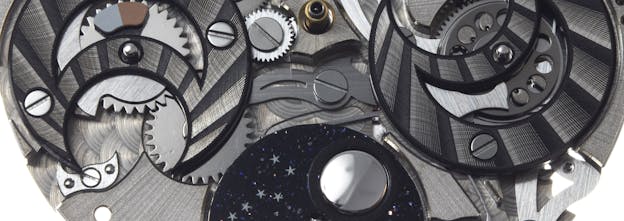A Look Under The Hood: The Calendar Complication Of The Parmigiani Fleurier Hijiri Perpetual Calendar
A world of hidden beauty is underneath the dial.
One of the most interesting calendar watches currently produced by any brand, is the Parmigiani Fleurier Tonda PF Hijiri Perpetual Calendar. This specific model was released this year but the complication at Parmigiani goes back to 2020, when the first version of the Hijiri Perpetual Calendar won the Innovation Prize at the GPHG. We covered the complication here at The 1916 Company editorial late last month, and there was quite a lot to say about it – an Islamic, purely lunar perpetual calendar, with a 30 year cycle, which keeps itself synchronized with the actual lunar months and the lunar year (of 12 lunar months) thanks to a relatively simple system of alternating 29 and 30 day months, combined with 11 leap years (termed “abundant” years) in which the 12th and final month has an additional day added.

Now if you are a student of and fan of calendar complications, including the annual, perpetual, and secular perpetual calendars you know that keeping the Gregorian calendar reconciled with the actual tropical year, so that things like the Equinoxes and the date of Easter happen more or less when they are supposed to. A standard calendar complication requires correction for every month shorter than 31 days; an annual calendar requires correction only at the end of February; a true perpetual calendar requires correction only once per century. Amazingly enough, the Hijiri calendar takes 2,500 years to accumulate a single day deviation from the actual lunar year.
A Gregorian perpetual calendar works through a mechanism relatively simple in its basic principles. At the heart of the complication is a multi-step cam which can have either 48 steps (for 48 months, or a full four year cycle) or 12 steps plus a leap year cam that rotates once a year, making a full revolution in four years, which is there to control the switching for the end of February. The day, date, week, and month indications as well as the moonphase are all indexed by a complex lever which is designed to fit around the under-dial motion works. Here’s an example from an A. Lange & Söhne pocket watch grand complication, no. 42005, from 1902.

This happens to be an instantly switching perpetual calendar, but the basic principle is the same as for a non-instant switching perpetual; you can see the 48 step program wheel at 12:00. It’s worth taking a moment to remember that in 1902, there were no spark erosion machines or CNC machines.
Having published the story, I realized that while I have a reasonable grasp of the workings of a perpetual calendar, I began to wonder exactly how the Hijiri perpetual complication worked. As the perpetual calendar works are hidden under the dial (this is basically true for all perpetual calendars) I went ahead and asked Parmigiani’s US press agency if they happened to have any images of the under-dial works. Just to keep us oriented, here are the perpetual calendar indications as you see them when the watch is on your wrist.

Much to my amazement, not only were there images but the images are also accompanied by a technical explanation. In 2022 the website, The Naked Watchmaker, posted a full teardown and technical analysis of the caliber PF009 (the website was founded by Diana Marin and Peter Speake; the latter left the project two years ago – one of his more recent projects was the Frederique Constant Slimline Perpetual Calendar). 
This is what is hiding under the dial and it is like nothing I’ve ever seen before. The moonphase disk is aventurine, and the two bridges for the months, on the right, and the date, on the left, are in the shape of rising and descending crescent moons. The geometric figure at the top is a very old symbol, known as the Rub el Hizb, which began to appear in Islamic iconography in the Iberian penninsula in the Middle Ages.

With the two bridges removed, you can see the calendar plate a little more clearly. The snail cam on the month wheel on the right turns once every year and when the lever riding on the cam drops onto the lower step, it indexes the year wheel one increment, turning it one full revolution every thirty years (the year wheel has thirty teeth).
On the left, you can see the lever and rack responsible for switching the indicator for the common and abundant months, which is controlled by a program disk.

There are a couple of quite amazing things about the movement – well more than a couple. The two that really stand out for me, though, are the ingenuity of the movement construction – I have never seen so many exquisitely shaped operating levers – and the amount of purely decorative character in the design of the calendar plate. Even the disk at 3:00 under the month indicator has lunar themed decoration; the cut-outs show the phases of the Moon and are, as The Naked Watchmaker says, “purely aesthetic.”
All this hidden glory is of course, part of a grand tradition in fine watchmaking of devoting great care and thought in design and execution to every part of the watch, even and especially to those parts visible only to the watchmaker. Still, the beauty of the movement was such a very pleasant surprise that it made me wonder if an open dial version of the watch might not be produced someday – certainly it would give us one heck of a lot to look at.
See the whole story, with many more images and detailed technical notes, at The Naked Watchmaker. All photos by The Naked Watchmaker; Lange Grand Complication calendar plate image via A. Lange & Söhne.

